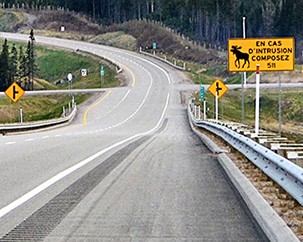Date & time
11:15 a.m. – 12:15 p.m.
Registration is closed
Registration is closed
Jochen Jaeger, Jonathan Wilansky, Claire Weiland, and Abigail Dawe-Roy
This event is free and open to the public
Loyola Jesuit Hall and Conference Centre
7141 Sherbrooke W.
Room 110
Yes - See details

This session features a series of student and faculty research presentations about road effects on wildlife and urban greenbelts.
Do wildlife crossing structures mitigate the barrier effect of roads on wildlife movement and what is the current evidence? This talk presents the results of an extensive literature review and synthesis addressing this question. We investigated whether wildlife passages prevented an expected decline in cross-road movement, restored movement to pre-construction conditions, or improved movement relative to no action. In an analysis of 313 studies, only 14% evaluated whether wildlife crossing structures resulted in a change in animal movement across roads. We identified critical problems in many existing studies, especially the lack of benchmarks (pre-road, pre-mitigation, or control data) and the use of biased comparisons. Wildlife crossing structures allowed cross-road movement in 98% of data sets. They improved movement in about 60%. In contrast, the decline of wildlife movement was prevented in fewer than 40% of cases. For most structure types and species groups, there was still insufficient evidence to draw generalised conclusions. The evidence to date suggests that wildlife crossing structures can mitigate the barrier effect of roads on wildlife movement, but they rarely completely mitigate the barrier effect. In many cases, the structures have been poorly implemented or poorly evaluated. The most supported measures are the addition of ledges and vegetation cover to increase movement for small mammals; underpasses to prevent the decline in movement of ungulates following road construction; and improving road-crossing for arboreal mammals using canopy bridges and vegetated medians. We strongly recommend that future crossing structures closely adhere to species-specific, best practice guidelines to improve implementation and be paired with a thorough evaluation that includes benchmark comparisons, particularly for structure types and species that need more evidence (e.g., amphibians, reptiles, birds, invertebrates, and overpasses). (Soanes et al. 2024, Journal of Applied Ecology).
Wildlife vehicle collisions on roads pose a major threat to biodiversity. Wildlife fencing can prevent animals from accessing a road and reduces road mortality significantly. However, fences that are too short generate a fence-end effect, where collision locations are shifted towards the fence ends. We created an individual-based model to study the fence-end effect and predict the effectiveness of fences at preventing road encounters based on fence length, home range size, and movement distances. We parameterized the model with wood turtle movement distances and compared 9 different movement profiles with varying fence-following distances. Fences shorter than the home range diameter of 600 m ranged from 0-69% effective, and effectiveness dropped proportionately to the animals’ fence-following distance. A mathematical function was created to predict effectiveness for fences of any length longer than the home range diameter. At 3000 m, fences ranged from 84-94% effective, proportionately related to the fence-following distance. Because of the fence-end effect, fences with an open end can approach but never reach 100% effectiveness. For wood turtles, we recommend a minimum length of 300 m (the home range radius) on either side of the location where turtles are present to account for home ranges centered close to the fence ends. Empirical data are needed to describe and quantify how animals behave when encountering a fence, as this behavior can significantly influence a fence’s effectiveness. Such data can help create species-specific models, inform effective fence lengths, and reduce mortality associated with the fence-end effect.
Roads act as wildlife barriers, cause road mortality, and habitat loss, reduce habitat quality, and decrease population persistence probability for many species. Wildlife can overcome the barrier effect by using existing crossing structures such as water culverts, but may be deterred by the presence of other species. Raccoons (Procyon lotor) are omnipresent in our study area and frequently observed in three monitored structures (M1, M2, B1). We investigated potential avoidance behaviour by other mammals toward raccoons. We recorded which species used each structure and at what frequencies (by season and throughout the observation period) and assessed the relationships between the occurrences of raccoons and other mammal species. We also examined whether mammals as individuals of three body-size categories (small, medium, large) followed raccoons within the same amount of time as when following an individual of the same body-size category. Observing potential avoidance behaviour would indicate that conservation efforts reliant on existing crossing structures may be counteracted by the ubiquitous presence of raccoons. No avoidance behaviour was observed based on weekly data. Rather, raccoon occurrences were positively associated with occurrences of other mammal species. Similarly, no avoidance behaviour from any mammal body-size category was observed based on hourly data, except for the medium body-size category at site M1 where the data indicated that individuals in this category took longer to follow raccoons than to follow each other (p < 0.05). This singular statistically significant result nevertheless warrants cautious consideration. Nonetheless, we advise studies assessing the effectiveness of existing crossing structures to also investigate species interactions.
This event is brought to you by the Loyola College for Diversity and Sustainability and the Loyola Sustainability Research Centre in collaboration with 4TH SPACE, with the support of the Office of the Vice-President, Research and Graduate Studies; the School of Community and Public Affairs and First Peoples Studies; the Science College; and the Departments of Biology; Communication Studies; Geography, Planning and Environment; and Political Science at Concordia University.
This event will contribute to the Sustainability in Research section of Concordia's Sustainability Action Plan by increasing the visibility of sustainability research at Concordia.
Hope and agency in uncertain times
© Concordia University